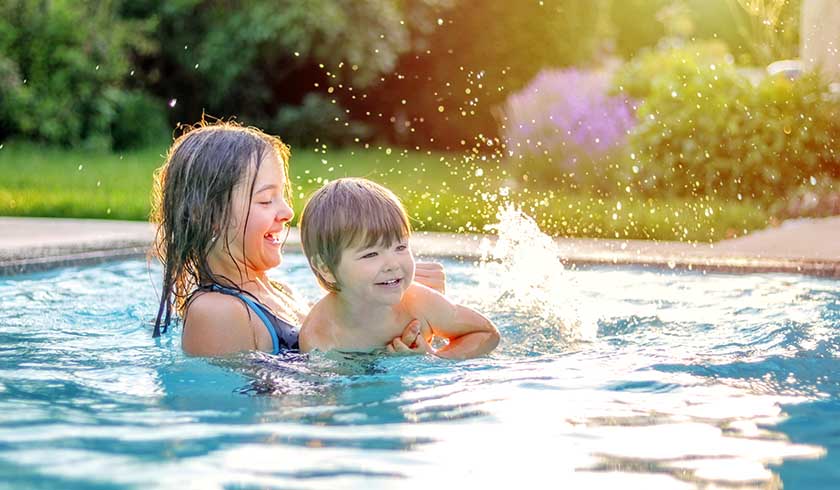A 5-part checklist for pool safety
Property owners who are now juggling work commitments from home while looking after children have been advised to be extra vigilant around risks and look at their swimming pool safety barrier.

Western Australia’s building and energy executive director, Saj Abdoolakhan, has highlighted that “many children do not have the maturity or experience to understand hazards and their potential consequences. Lack of adult supervision for even a moment can result in disaster”.
Not only is Mr Abdoolakhan encouraging parents to take a look at all potential risk areas around the home and implement precautions where possible, he homed in on swimming pool safety barriers as one particular area worthy of special attention.
“There is no substitute for close adult supervision, but simple checks and steps can add an extra layer of protection,” Mr Abdoolakhan said.
To help residents gauge the effectiveness of their swimming pool safety barriers, the Building and Energy division of the state government has released a simple checklist to cover key legal requirements of the pool barriers’ required measurements, operation and condition.
SPI reminds owners and occupiers of properties containing swimming pools that they share a responsibility to ensure the safety barrier is compliant at all times, but only a local government can confirm whether or not the safety barrier is compliant.
This barrier and the gate must be continually maintained with the gate self-closing and self-latching when released from any open position, even resting on the latch.
The information sheet reminds owners and occupiers that safety barriers are intended to be child-resistant, not child proof, and as such adults must supervise young children and must never solely rely on the pool safety barriers.
In addition, WA guidelines state that failure to have a compliant safety barrier around a private swimming pool can result in an infringement notice of $1,000.
In court, a penalty of up to $5,000 may be imposed, plus costs.
To minimise risks associated with a pool or spa, here’s what an owner and/or an occupier should check:
-
Pool gates
The most important element of compliance according to the government.
-
does the pool gate should close by itself from any open position, including from resting on the latch?
-
Does the self-latching device work properly?
-
Is the gate secure when closed?
-
Does the gate open outwards away from the pool area?
-
Is the latch mechanism at least 1.5m from the ground OR on the inside of the gate at least 15cm below the top and shielded from any other opening by at least 45cm?
-
Pool fence
-
Is the fence fixed securely in place?
-
Is the outside of the fence at least 1.2m high?
-
Are all vertical uprights in the fence spaced less than 10cm apart?
-
Is there at least 90cm between handholds and footholds?
-
Is the bottom of the fence 10cm or less from the ground?
-
Is the surface beneath the fence stable and not easily eroded?
-
Is the fence in good condition?
-
Is the boundary fence also in good condition?
-
Climbable objects
Barbecues, plants, trees, pot plants, plumbing, toys, furniture, retaining walls and pool pumps may all aid a young child in climbing over a pool fence, the government has advised.
-
Is the pool area clear of items that may or can assist a child to climb over the fence or reach the gate latch?
-
Are climbable surfaces, outside of the pool area, located at least 90cm from the top of the fence?
-
Are climbable surfaces, inside of the pool area, located at least 30cm away from the inside of the pool fence?
-
Child-resistant window
-
Key locks are NOT considered a permanent restriction
-
Is the openable portion of a window permanently restricted to open no more than 10cm by a device that requires the use of a tool to remove it OR is the window covered by bars or a metal screen that is also fixed in place by a device requiring the use of a tool to remove it?
-
Child-resistant door (where permitted)
Post-November 2001, doors aren’t generally permitted to form part of a pool barrier unless specific local government approval has been granted.
-
Does the door close by itself from any open position, including from resting on the latch?
-
Does the self-latching device work properly?
-
Is the door secure when closed?
-
Is the latch release mechanism at least 1.5m above the floor?
-
Pet doors ARE NOT permitted to form any part of a pool safety barrier.
In summary, here are some extremely important pieces of advice:
-
Never prop a pool gate open.
-
Keep your pool gate maintained: Ensure it can self-close and self-latch.
-
Actively supervise children within an arm’s reach whenever they are in, or around, water.
-
Never rely on older children to supervise younger children.
-
Ensure your barrier is clear of climbable objects.
-
Consider the merits of a pool gate alarm.
Tags:

